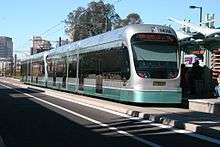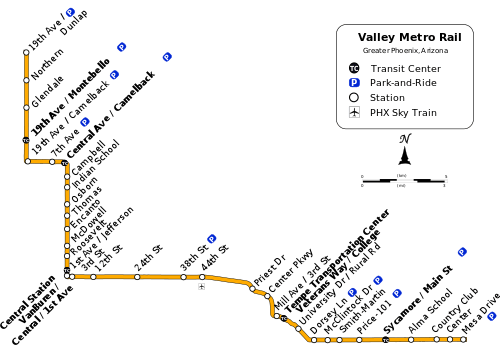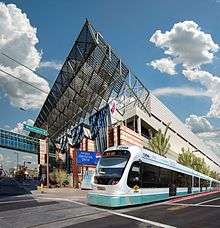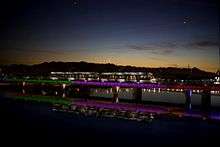Valley Metro Rail
Valley Metro Rail (styled corporately as METRO) is a 26.3-mile (42 km)[1] light rail line operating in the U.S. state of Arizona. Part of the Valley Metro public transit system, it serves the cities of Phoenix, Tempe, and Mesa. Construction began in March 2005; operation started December 27, 2008. The line had a weekday ridership of 43,543 in 2015, making it the 13th busiest light rail system in the country.[2]
In the years since it opened in 2008, the system has undergone two expansions, with at least five more scheduled, including Tempe Streetcar. Furthermore, extensions are planned in Glendale, and into South Phoenix to Baseline Road, all of which were expanded as a direct result of obtaining funding under the Proposition 104 sales tax increase.
Cost and infrastructure

The expected construction cost for the initial 20 miles was $1.4 billion, or $70 million per mile.[3] In 2008, Valley Metro estimated the train would cost $184 million to operate over the following five years with fares covering $44 million of the operation costs and tax subsidies covering the remaining costs.[4]
Trains operate on city streets in a "center reservation", similar to the Red Line of the METRO light rail system in Houston, the surface sections of the Green Line in Boston, and some surface sections of the Muni Metro in San Francisco. Some parts of the line, such as the bridge over Tempe Town Lake (near State Route 202), have no contact with other traffic. The vehicles used are rated for a maximum speed of 58 mph, and have to complete the 26 mile route in 90 minutes, including station stops.[5] The system is powered by an overhead catenary that supplies power at 750 V.[6]
History
Numerous plans have preceded the current implementation of light rail. The Phoenix Street Railway provided streetcar service from 1887 to 1948. Historic vehicles may be seen at the Arizona Street Railway Museum, with Car #116 celebrating her 80th birthday on December 25, 2008, just days before the opening of modern rail service. In 1989, the ValTrans elevated rail proposal,[7] was turned down by voters in a referendum due to cost and feasibility concerns. Other subsequent initiatives during the 1990s failed over similar reasons.
Metro was created by the Transit 2000 Regional Transportation Plan (RTP), which involved a 0.5 per cent sales tax and was approved by voters in Phoenix in 2000. Transit 2000 aimed at improving the local bus service (considered unacceptably inadequate compared to other major US cities) and the formation of bus rapid transit and light rail, among other things, which was seen as a more affordable approach. It used the route placing and color designations from the 1989 plan.
Construction on a new light rail line began in March 2005. In March 2008, cracks in the system's rails were discovered. The cause of the cracks was determined to be improper use of plasma cutting torches by contractors.[8] The affected track was repaired by May at a cost of $600,000 with still no word on which parties will be held financially responsible.[9] The last of the concrete and rail for the system was installed in the end of April, with CEO declaring the system to be on time and on budget.[10]
There are 28 stations on the initial twenty-mile starter segment. The line celebrated its grand opening December 27, 2008, with official ribbon-cutting ceremonies and community celebrations spread throughout Phoenix, Tempe, and Mesa. The event was produced by Arizona's Entertainment Solutions, Inc.[11] and was attended by thousands of local residents who waited as long as an hour or more to ride the vehicles.[12][13] The stations have been designed to complement their immediate surroundings.[14] Station platform areas are approximately 16 feet (4.9 m) wide by 300 feet (91 m) long.
As of early 2014, income has exceeded Metro's stated goal with 44.6% farebox recovery, partially due to the light rail ridership far exceeding original projections. The light rail has also led to rapid urban development in downtown Phoenix and Tempe, generating additional revenue through taxes.
Valley Metro had its busiest month in February 2014, with a weekday ridership of 48,924. On December 7, 2013, they saw 65,773 board the train thanks to fans attending Arizona State University Pac 12 Championship football game, Tempe Festival of the Arts, APS Electric Light Parade and the Beyoncé concert at US Airways Center.[15]
Central Mesa Extension
The Central Mesa Extension extended 3.1 miles (5.0 km) from Sycamore/Main St in the median of Main Street to Mesa Drive.[16] It added four stations at Alma School Road, Country Club Drive, Center Street, and Mesa Drive. In March 2012, Valley Metro selected a design-build joint venture between Kiewit Corporation and Mass. Electric to construct the extension.[17] Construction began in July 2012, and passenger service began on August 22, 2015.[18] Mesa held a summit in early 2012 to have urban developers give their ideas on how to revitalize Downtown Mesa.[19] The extension cost $200 million, paid for from a combination of Proposition 400 sales tax revenues and federal air quality and New Starts grants, and is estimated to have added 5,000 daily riders.[16]
Northwest Phase I
An original part of the Regional Transportation Plan, this extension was originally scheduled to open in 2012.[20] However, a combination of lower than expected sales tax revenues, combined with uncertainty surrounding the availability of federal funds to support the project resulted in the opening date being pushed back initially to 2014, and then by 9 years, to fiscal year 2023, by the Phoenix City Council in June 2009.[21]
In July 2012, a vote was held to reschedule this extension to open in 2016. Under this plan, the city of Phoenix advanced $60 million of local funds to Valley Metro Rail, who would then fund the remaining cost of the project (approximately $267 million) with both Transit 2000 and Proposition 400 funds,[22] thereby allowing work on the project to begin.
The design-build contract was awarded to a joint venture of Sundt and Stacy and Witbeck, for the 3.2 mile extension.[23] Construction began in January 2013,[24] with a celebration to mark the laying of the first track section being held in July 2014.[25] Construction work continued until December 2015, when it was announced the extension would open March 19, 2016 and that testing along the new stretch would continue.[26][27]
This extension is the first to extend light rail within the city of Phoenix. The system continues north from the previous terminus at 19th Avenue and Montebello, along the median of 19th Avenue, to a new terminus and park and ride located on the southwest corner of 19th Ave/Dunlap. The extension features two additional stations, located at Northern and Glendale avenues and is predicted to serve 5,000 riders per day during its first full year of operation.
Operations
Route description

Currently the Valley Metro Rail system consists of one single line serving all 35 stations total, and denoted with a gold-yellow color on Valley Metro publications.[28] The line starts in Phoenix at the 19th Ave/Dunlap station on its own right of way south of Dunlap before turning south on 19th Avenue for four miles. It then turns eastward on Camelback Road for 2 1/2 miles, then turns south onto Central Avenue where it continues all the way into Downtown Phoenix. At Roosevelt, the line splits into one-way segments: the Mesa bound portions line runs on First Avenue south before turning east on Jefferson Street; likewise, the Dunlap bound portion of the line starts at 26th Street on Washington Street before turning north on Central Avenue. (Interestingly, between 5th and 26th Streets on the Washington/Jefferson corridors, the Valley Metro Rail has a distinction of running in the middle of one-way thoroughfares.) After both tracks rejoin east of 24th Street on Washington Street, it continues past Sky Harbor Airport (which is connected by the PHX Sky Train to the light rail), then turns southeast ward crossing into Tempe. The line leaves Washington Street and crosses Tempe Town Lake on its own bridge, turns east along Mill Street before going into its own right of way near ASU. Going southward, it joins Apache Boulevard going east ward, with Apache changing to Main Street in Mesa where the light rail line ends at Mesa Drive.
Hours and headways
Valley Metro Rail begins operations Monday through Friday at 4:30 a.m., and Saturdays and Sundays at 4:50 a.m.[29] It ends service at 11 p.m. Monday through Thursday nights, and weekend service ends at 2 a.m. late Friday and Saturday nights/early Saturday and Sunday mornings. Due to the fact a complete light rail trip takes 83 minutes from end to end, trains departing at 11 p.m. for example end by 12:25 a.m. Weekday frequencies consist of every 12 minutes, Saturday daytime service every 15 minutes and Sunday and evening service being every 20 minutes. Additional trips operating before and after full service hours do not complete their trip; many end at the final revenue station before entering the LRV storage yard.
Rolling stock
Metro operates a fleet of 50 light rail vehicles (LRV) manufactured by Kinki Sharyo. Each LRV seats 66, with a total capacity including standees of 200. The vehicles are accessible with space for four wheelchairs and four bicycles, per vehicle. Up to three vehicles may operate together in a single train set.[30] The vehicles have a maximum speed of 58 mph (93 km/h).[31]
| Builder | Model | In service | Road numbers | Years of service |
|---|---|---|---|---|
| Kinki Sharyo | Low Floor Light Rail Vehicle[32] | 50 | 101–150 | 2008–present |
Fares
Valley Metro Rail shares its fare system with the Valley Metro Bus system, but uses a proof-of-payment system to allow for simplified boarding and platform access. Tickets can be purchased from ticket vending machines at the entrance to all stations but must be validated before boarding the train.[33]
Fare enforcement sweeps are conducted throughout the system at random to ensure compliance. The system currently has a fare compliance rate of 94%, with an average of 16% of fares being validated by inspectors.[34]
Future extensions and improvements

Gilbert Road (2018)
An eastern extension, 1.9 miles (3.1 km) past the current terminus at Mesa Drive to Gilbert Road, is in the planning and design phase, with construction scheduled to begin in August 2016, and operations expected in September 2018.[35] The line, budgeted at approximately $147.1 million, will travel in the median of Main Street and have two stations. The design-build contract for this project was awarded to Sundt/Stacy and Witbeck, with Jacobs Engineering providing design services for the project.[36][37]
Tempe Streetcar (2019)

.jpg)
Tempe Streetcar will consist of 13 stations, running from Dorsey Lane east on Apache Boulevard, then north on Mill Avenue.[38] From there, it will loop around Downtown Tempe along Mill and Ash avenues.[39] The route continues along Rio Salado Parkway to Marina Heights, with a possible extension to Mesa to connect with the Cubs' new spring training facility, as well as Tempe Marketplace and future development along Rio Salado.[40][41]
Northwest Phase II (2023)
Upon completion of Northwest Phase I, focus now shifts to Phase II of the project. Estimated to be complete by 2023, this extension will continue west on Dunlap Avenue before turning to head north along 25th Avenue. From there, the system will head west on Mountain View Road, before crossing Interstate 17 and terminating on the east side of Metrocenter Mall. The extension is expected to include three new stations, one in the vicinity of 25th Avenue and Dunlap, another adjacent to the Rose Mofford Sports Complex and a new transit center on the east side of Metrocenter Mall.[36]
As of March 2016, the project is currently in the advanced conceptual engineering phase. Construction on this project is likely to begin in 2020, with a budget of approximately $285 million.[42]
Capitol/I-10 West extension (Phase I: 2023, Phase II: 2030)
The Capitol/I-10 West extension will run from Downtown Phoenix from Central Station and 1st Avenue/Jefferson west to Interstate 17 and turn north to the interchange of Interstate 10 and I-17 ("The Stack"). Then the line will turn west and continue down I-10 in the median past 43rd Avenue. It will then go over the westbound lanes of I-10 to continue alongside the highway to the 79th Avenue park and ride, adding 11 miles (18 km) and 10 stations to connect the West Valley and ease congestion on Interstate 10.[43] The line will transfer over I-10 from the median to the shoulder to accommodate the proposed extension of Loop 202, which will connect with I-10 around 51st Avenue.[44] The extension, currently in the environmental assessment phase, is scheduled to be in operation by 2023 and cost $1 billion.[36][45]
South Central Extension (2023)
The South Central Extension[46] will run from Downtown Phoenix south along Central Avenue to Baseline Road, adding 4.9 miles (7.9 km) and seven stations. The extension received Federal Transportation Administration (FTA) approval into the Capital Investment Grant program in December 2015.[47] After having received approval, the extension will now enter a further environmental assessment and preliminary engineering phase, and remains scheduled to be in operation by 2023.[36]
West Phoenix/Glendale (2026)

Starting in 2013, Valley Metro along with the cities of Glendale and Phoenix approved a project to study the potential extension of light rail, bus rapid transit or streetcar to Glendale. Initially three different route options were proposed, all of which headed west from the current light rail system and featured a shared terminus in the Downtown Glendale area. Options included travel directly across Glendale Avenue, as well as routes which travel along Camelback Road and a combination of 43rd and 51st avenues, before entering the shared downtown terminus area.
In February 2016, a community working group recommend a route for this project, this route travels along Camelback Road until 43rd Avenue, at which point light rail would travel north along 43rd Avenue until Glendale Avenue, from there it would continue west until it reaches 56th Avenue, where the route is likely to shift approximately 500 feet (150 m) north to Glenn Drive, where it will continue to the downtown terminus. Light rail was selected as the preferred type of transit for the route, as opposed to bus rapid transit or streetcar.[48]
Following the recommendation, the project now enters a technical definition phase, to better identify how the line would cross Interstate 17, in addition to defining how the route will transition from Glendale Avenue to Glenn Drive in downtown Glendale. Upon completion of this phase, the route will be presented for approval to both Glendale and Phoenix city councils.[49]
Any project which occurs as a result of this study will have a budget of $543 million, with construction to begin in 2023 and operations to begin in 2026.[50]
50th Street infill station (2019)
Currently, Valley Metro is studying adding an infill station at 50th Street, which would fill a gap between stations in East Phoenix. Following the passage of Proposition 104 in 2015, funding was made available to construct the station, upon completion of planning, design work and right of way acquisition.[51]
Future extensions
Currently, an extension is planned to occur in Northeast Phoenix in 2034, and Arizona State University's West campus in 2044.[36]
Construction starts on Mesa light-rail extension to Gilbert Road [52] 2016.
See also
- PHX Sky Train
- Phoenix Public Transportation
- Light rail in North America
- List of tram and light rail transit systems
- List of rail transit systems in the United States
References
- 1 2 "Go Discover Mesa! Three New Miles of Light Rail Service Begins" (Press release). Valley Metro. August 22, 2015. Retrieved September 9, 2015.
- ↑ "Ridership Reports". Valley Metro. Retrieved February 22, 2016.
- ↑ "FAQs and Fast Facts" (pdf). - ValleyMetro.org. Archived December 17, 2007, at the Wayback Machine.
- ↑ http://www.azcentral.com/news/articles/2008/12/09/20081209lrail-money1209.html
- ↑ "Valley Metro Rail - Timetable". March 19, 2016. Retrieved March 20, 2016.
- ↑ "Fast facts" (pdf). ValleyMetro.org. September 14, 2011. p. 6. Retrieved August 10, 2014.
- ↑ Phoenix Transit Elections. - Arizona Rail Passenger Association. Archived August 12, 2007, at the Wayback Machine.
- ↑ Light-rail cracks: Who is at fault?. - Arizona Republic. - AZCentral.com.
- ↑ "30 light-rail sections fixed at cost of $600K". - Arizona Republic. - AZCentral.com. - May 16, 2008.
- ↑ "Light-rail construction: The end is near?". - Arizona Republic. - AZCentral.com. - April 29, 2008.
- ↑ "Entertainment Solutions Inc". Solutionsaz.com. Retrieved October 17, 2013.
- ↑ http://www.azcentral.com/news/traffic/lightrail/articles/2008/12/27/20081227lightrail-ON.html
- ↑ "Phoenix Light Rail Grand Opening 12/27/08 08:00 AM". Valley Metro. December 27, 2008. Archived from the original on February 9, 2009. Retrieved December 25, 2008.
- ↑ "Light Rail Station Design". Valley Metro. Retrieved February 20, 2008.
- ↑ "Record Ridership on December 7" (Press release). Valley Metro. December 11, 2013. Retrieved August 10, 2014.
- 1 2 "Central Mesa Light Rail Extension" (PDF). Valley Metro. December 2014. Retrieved May 9, 2015.
- ↑ "Design-Build Contractor Selected for Central Mesa Extension" (Press release). Valley Metro. March 22, 2012. Retrieved May 9, 2015.
- ↑ Mitchell, Garrett (August 22, 2015). "Mesa light rail expansion debuts to thousands of riders". The Arizona Republic. Retrieved August 25, 2015.
- ↑ Groff, Garin (February 16, 2012). "Downtown Mesa summit to tackle urban development along light rail - East Valley Tribune: Mesa". East Valley Tribune. Retrieved October 17, 2013.
- ↑ "Valley Metro - RTP Brochure" (PDF). p. 9. Retrieved 20 March 2016.
- ↑ Holstege, Sean (June 25, 2009). "Light-rail extension planned for 19th Ave. delayed until 2014". The Arizona Republic. Retrieved 20 March 2016.
- ↑ Bui, Lynh (July 21, 2012). "Phoenix OKs plan to accelerate light-rail extens". The Arizona Republic. Retrieved 20 March 2016.
- ↑ "Sundt Construction-Stacy and Witbeck Joint Venture Chosen To Extend Valley Metro Light Rail Line". April 5, 2013. Retrieved 20 March 2016.
- ↑ "Sundt Partnership Breaks Ground on Phoenix Light Rail Project". January 15, 2013. Retrieved 20 March 2016.
- ↑ "Community Celebrates Progress of the Northwest Light Rail Extension". Retrieved 20 March 2016.
- ↑ "Northwest Extension Marks Arrival of Trains". Valley Metro. Retrieved 20 March 2016.
- ↑ Goth, Brenna (December 10, 2015). "Northwest Phoenix light-rail extension to open in March". The Arizona Republic. Retrieved 20 March 2016.
- ↑ http://www.valleymetro.org/images/uploads/Valley_Metro_System_Map_April_2016.pdf Valley Metro System Map (April 2016)
- ↑ http://routes.valleymetro.org/system/transit_routes/route_pdfs/000/000/695/original/vmr.pdf?1458146842 Valley Metro Rail schedule
- ↑ Holle, Gina. "Phoenix Light Rail: On Track" (PDF). Community Transportation Association of America. Retrieved January 15, 2015.
- ↑ "Phoenix - Valley Metro Rail: Technical Data" (PDF). Kinki Sharyo. Retrieved January 15, 2015.
- ↑ "Valley Metro Rail, USA Low Floor Light Rail Vehicle". Kinki Sharyo. Retrieved January 15, 2015.
- ↑ "Proof of Payment - Valley Metro". Retrieved 22 February 2016.
- ↑ "Valley Metro RMC Minutes (February 3, 2016)" (PDF). Valley Metro. pp. 198–199. Retrieved 22 February 2016.
- ↑ Guzzon, John (December 21, 2015). "Sundt/Stacy and Witbeck To Begin Light Rail Extension Construction in 2016". Retrieved 20 March 2016.
- 1 2 3 4 5 Goth, Brenna (9 February 2016). "South Phoenix light rail on fast track, to come a decade early". Arizona Republic. Retrieved 15 February 2016.
- ↑ "Gilbert Road Light Rail Extension" (PDF). Valley Metro. April 2015. Retrieved June 5, 2015.
- ↑ "Tempe Streetcar" (PDF). Valley Metro. December 2014. Retrieved May 9, 2015.
- ↑ "Valley Metro - Tempe Streetcar". Valley Metro. Retrieved March 20, 2016.
- ↑ "South Bank - Mixed Use Urban Community Development - Tempe Town Lake, Tempe, AZ". Southbanktempe.com. Retrieved October 17, 2013.
- ↑ "Downtown Tempe - Hayden Ferry Lakeside". Haydenferry.com. Retrieved October 17, 2013.
- ↑ "Northwest Phase II Report Card" (PDF). Valley Metro. Retrieved 20 March 2016.
- ↑ "Providing Public Transportation Alternatives for the Greater Phoenix Metro Area | Valley Metro | METRO I-10 West Extension". Valley Metro. May 3, 2012. Retrieved October 17, 2013.
- ↑ "Projects". Azdot.gov. September 30, 2013. Retrieved October 17, 2013.
- ↑ "Capitol/I-10 West Light Rail Extension" (PDF). Valley Metro. March 2015. Retrieved May 9, 2015.
- ↑ "Valley Metro" (PDF).
- ↑ "Significant Step for South Central Project - Valley Metro". www.valleymetro.org. Retrieved 2015-12-10.
- ↑ Giblin, Paul (February 11, 2016). "Valley Metro picks preferred light-rail route through west Phoenix into downtown Glendale". The Arizona Republic. Retrieved 20 March 2016.
- ↑ "West Phoenix / Central Glendale Project Update" (PDF). Valley Metro. Retrieved 20 March 2016.
- ↑ "West Phoenix / Central Glendale Public Meeting Presentation" (PDF). January 19, 2016. Retrieved 20 March 2016.
- ↑ "50th Street Station Project". Valley Metro. Retrieved 15 February 2016.
- ↑ http://www.azcentral.com/story/news/local/mesa/2016/11/29/work-starts-next-mesa-light-rail-segment-valley-metro/94170306/
External links
| Wikimedia Commons has media related to Valley Metro Rail. |
- Official website
- Article on Valley Metro Rail and preemptive urban revitalization
- Slideshow of photos on light rail construction and progress -- from azcentral.com
- http://phoenixtrolley.com/history/history-of-transit/
- http://www.azcentral.com/story/news/local/phoenix/2016/02/09/south-phoenix-light-rail-fast-track-come-decade-early/79653582/
- http://www.azcentral.com/story/opinion/op-ed/joannaallhands/2016/02/15/transit-phoenix/80308204/
